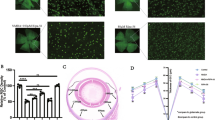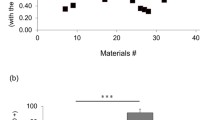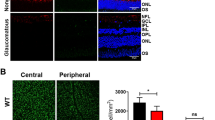Abstract
Lutein injection is a possible therapeutic approach for retinal diseases, but the molecular mechanism of its neuroprotective effect remains to be elucidated. The aim of this study was to investigate its protective effects in retinal ganglion cells (RGCs) against N-methyl-d-aspartate (NMDA)-induced retinal damage in vivo. Retinal damage was induced by intravitreal NMDA injection in rats. Each animal was given five daily intraperitoneal injections of Lutein or vehicle along with intravitreal NMDA injections. Electroretinograms were recorded. The number of viable RGCs was quantified using the retinal whole-mount method by immunofluorescence. Proteins were measured by Western blot assays. Lutein reduced the retinal damage and improved the response to light, as shown by an animal behavior assay (the black-and-white box method) in rats. Furthermore, Lutein treatment prevented the NMDA-induced reduction in phNR wave amplitude. Lutein increased RGC number after NMDA-induced retina damage. Most importantly, Bax, cytochrome c, p-p38 MAPK, and p–c-Jun were all upregulated in rats injected with NMDA, but these expression patterns were reversed by continuous Lutein uptake. Bcl-2, p-GSK-3β, and p-Akt in the Lutein-treated eyes were increased compared with the NMDA group. Lutein has neuroprotective effects against retinal damage, its protective effects may be partly mediated by its anti-excitability neurotoxicity, through MAPKs and PI3K/Akt signaling, suggesting a potential approach for suppressing retinal neural damage.






Similar content being viewed by others
Abbreviations
- RGCs:
-
Retinal ganglion cells
- ERG:
-
Electroretinograms
- phNR:
-
Photic negative response
- RIPA:
-
Radio immunoprecipitation assay
- SDS-PAGE:
-
Sodium dodecyl sulfate-polyacrylamide gel electrophoresis
- PVDF:
-
Polyvinylidene fluoride
- ECL:
-
Electrochemiluminescence
- AkT:
-
Protein kinase B/PKB
- ERK:
-
Extracellular signal-regulated kinase
- GSK-3β:
-
Glycogen synthase kinase-3β
- MAPK:
-
Mitogen-activated protein kinases
References
Chen H, Zhang M, Huang S, Wu D (2008) The photopic negative response of flash ERG in nonproliferative diabetic retinopathy. Doc Ophthalmol 117:129–135
Chen WJ, Wang LX, Wang YP, Chen Z, Liu XY, Liu XH, Liu LB (2012) Exendin-4 Protects MIN6 Cells from t-BHP-Induced Apoptosis via IRE1-JNK-Caspase-3 Signaling. Int J Endocrinol 2012:549081
Dun Y, Thangaraju M, Prasad P, Ganapathy V, Smith SB (2007) Prevention of excitotoxicity in primary retinal ganglion cells by (+)-pentazocine, a sigma receptor-1 specific ligand. Invest Ophthalmol Vis Sci 48:4785–4794
Dvoriantchikova G, Degterev A, Ivanov D (2014) Retinal ganglion cell (RGC) programmed necrosis contributes to ischemia-reperfusion-induced retinal damage. Exp Eye Res 123:1–7
Gallenmuller C, Klopstock T (2014) Leber’s hereditary optic neuropathy—phenotype, genetics, therapeutic options. Klinische Monatsblatter fur Augenheilkunde 231:216–221
Granado F, Olmedilla B, Blanco I (2003) Nutritional and clinical relevance of lutein in human health. Br J Nutr 90:487–502
Han L, Du LB, Kumar A, Jia HY, Liang XJ, Tian Q, Nie GJ, Liu Y (2012) Inhibitory effects of trolox-encapsulated chitosan nanoparticles on tert-butylhydroperoxide induced RAW264.7 apoptosis. Biomaterials 33:8517–8528
Huang L, Shen X, Fan N, He J (2012) Clinical application of photopic negative response of the flash electroretinogram in primary open-angle Glaucoma. Eye Sci 27:113–118
Huang L, Balsara RD, Castellino FJ (2014) Synthetic conantokin peptides potently inhibit N-methyl-d-aspartate receptor-mediated currents of retinal ganglion cells. J Neurosci Res 92:1767–1774
Ishizuka F, Shimazawa M, Umigai N, Ogishima H, Nakamura S, Tsuruma K, Hara H (2013) Crocetin, a carotenoid derivative, inhibits retinal ischemic damage in mice. Eur J Pharmacol 703:1–10
Johnson EJ (2014) Role of lutein and zeaxanthin in visual and cognitive function throughout the lifespan. Nutr Rev 72:605–612
Kijlstra A, Tian Y, Kelly ER, Berendschot TT (2012) Lutein: more than just a filter for blue light. Prog Retin Eye Res 31:303–315
Kim KA, Shim SH, Ahn HR, Jung SH (2013) Protective effects of the compounds isolated from the seed of Psoralea corylifolia on oxidative stress-induced retinal damage. Toxicol Appl Pharmacol 269:109–120
Lee DK, Grantham RN, Mannion JD, Trachte AL (2006) Carotenoids enhance phosphorylation of Akt and suppress tissue factor activity in human endothelial cells. J Nutr Biochem 17:780–786
Li GY, Fan B, Su GF (2009a) Acute energy reduction induces caspase-dependent apoptosis and activates p53 in retinal ganglion cells (RGC-5). Exp Eye Res 89:581–589
Li SY, Fu ZJ, Ma H, Jang WC, So KF, Wong D, Lo AC (2009b) Effect of lutein on retinal neurons and oxidative stress in a model of acute retinal ischemia/reperfusion. Invest Ophthalmol Vis Sci 50:836–843
Li SY, Yang D, Fu ZJ, Woo T, Wong D, Lo AC (2012a) Lutein enhances survival and reduces neuronal damage in a mouse model of ischemic stroke. Neurobiol Dis 45:624–632
Li SY, Fung FK, Fu ZJ, Wong D, Chan HH, Lo AC (2012b) Anti-inflammatory effects of lutein in retinal ischemic/hypoxic injury: in vivo and in vitro studies. Invest Ophthalmol Vis Sci 53:5976–5984
Li GY, Li T, Fan B, Zheng YC, Ma TH (2012c) The D(1) dopamine receptor agonist, SKF83959, attenuates hydrogen peroxide-induced injury in RGC-5 cells involving the extracellular signal-regulated kinase/p38 pathways. Mol Vis 18:2882–2895
Lin HJ, Chao PD, Huang SY, Wan L, Wu CJ, Tsai FJ (2007) Aloe-emodin suppressed NMDA-induced apoptosis of retinal ganglion cells through regulation of ERK phosphorylation. Phytother Res 21:1007–1014
Lin B, Koizumi A, Tanaka N, Panda S, Masland RH (2008) Restoration of visual function in retinal degeneration mice by ectopic expression of melanopsin. Proc Natl Acad Sci USA 105:16009–16014
Lo HM, Tsai YJ, Du WY, Tsou CJ, Wu WB (2012) A naturally occurring carotenoid, lutein, reduces PDGF and H(2)O(2) signaling and compromised migration in cultured vascular smooth muscle cells. J Biomed Sci 19:18
Lo HM, Chen CL, Yang CM, Wu PH, Tsou CJ, Chiang KW, Wu WB (2013) The carotenoid lutein enhances matrix metalloproteinase-9 production and phagocytosis through intracellular ROS generation and ERK1/2, p38 MAPK, and RARbeta activation in murine macrophages. J Leukoc Biol 93:723–735
Machida S, Gotoh Y, Tanaka M, Tazawa Y (2004) Predominant loss of the photopic negative response in central retinal artery occlusion. Am J Ophthalmol 137:938–940
Manabe S, Lipton SA (2003) Divergent NMDA signals leading to proapoptotic and antiapoptotic pathways in the rat retina. Invest Ophthalmol Vis Sci 44:385–392
Manning BD, Cantley LC (2007) AKT/PKB signaling: navigating downstream. Cell 129:1261–1274
Miyake S, Kobayashi S, Tsubota K, Ozawa Y (2014) Phase II enzyme induction by a carotenoid, lutein, in a PC12D neuronal cell line. Biochem Biophys Res Commun 446:535–540
Nakazawa T, Shimura M, Endo S, Takahashi H, Mori N, Tamai M (2005) N-Methyl-d-Aspartic acid suppresses Akt activity through protein phosphatase in retinal ganglion cells. Mol Vis 11:1173–1182
Osborne NN, Casson RJ, Wood JP, Chidlow G, Graham M, Melena J (2004) Retinal ischemia: mechanisms of damage and potential therapeutic strategies. Prog Retin Eye Res 23:91–147
Parisi V, Tedeschi M, Gallinaro G, Varano M, Saviano S, Piermarocchi S, Group CS (2008) Carotenoids and antioxidants in age-related maculopathy italian study: multifocal electroretinogram modifications after 1 year. Ophthalmology 115(324–333):e322
Park HY, Kim JH, Park CK (2014) Neuronal cell death in the inner retina and the influence of vascular endothelial growth factor inhibition in a diabetic rat model. Am J Pathol 184:1752–1762
Rangaswamy NV, Frishman LJ, Dorotheo EU, Schiffman JS, Bahrani HM, Tang RA (2004) Photopic ERGs in patients with optic neuropathies: comparison with primate ERGs after pharmacologic blockade of inner retina. Invest Ophthalmol Vis Sci 45:3827–3837
Rathnasamy G, Sivakumar V, Rangarajan P, Foulds WS, Ling EA, Kaur C (2014) NF-kappaB-mediated nitric oxide production and activation of caspase-3 cause retinal ganglion cell death in the hypoxic neonatal retina. Invest Ophthalmol Vis Sci 55:5878–5889
Sasaki M, Ozawa Y, Kurihara T, Kubota S, Yuki K, Noda K, Kobayashi S, Ishida S, Tsubota K (2010) Neurodegenerative influence of oxidative stress in the retina of a murine model of diabetes. Diabetologia 53:971–979
Sies H, Stahl W, Sundquist AR (1992) Antioxidant functions of vitamins. Vitamins E and C, beta-carotene, and other carotenoids. Ann N Y Acad Sci 669:7–20
Siliprandi R, Lipartiti M, Fadda E, Sautter J, Manev H (1992) Activation of the glutamate metabotropic receptor protects retina against N-methyl-d-aspartate toxicity. Eur J Pharmacol 219:173–174
Suhs KW, Fairless R, Williams SK, Heine K, Cavalie A, Diem R (2014) N-methyl-d-aspartate receptor blockade is neuroprotective in experimental autoimmune optic neuritis. J Neuropathol Exp Neurol 73:507–518
Sun YX, Liu T, Dai XL, Zheng QS, Hui BD, Jiang ZF (2014) Treatment with lutein provides neuroprotection in mice subjected to transient cerebral ischemia. J Asian Nat Prod Res 16:1084–1093
Tezel G (2006) Oxidative stress in glaucomatous neurodegeneration: mechanisms and consequences. Prog retin Eye Res 25:490–513
Thomson LR, Toyoda Y, Langner A, Delori FC, Garnett KM, Craft N, Nichols CR, Cheng KM, Dorey CK (2002) Elevated retinal zeaxanthin and prevention of light-induced photoreceptor cell death in quail. Invest Ophthalmol Vis Sci 43:3538–3549
Tian B, Xu Z, Sun Z, Lin J, Hua Y (2007) Evaluation of the antioxidant effects of carotenoids from Deinococcus radiodurans through targeted mutagenesis, chemiluminescence, and DNA damage analyses. Biochim Biophys Acta 1770:902–911
Verma YK, Raghav PK, Raj HG, Tripathi RP, Gangenahalli GU (2013) Enhanced heterodimerization of Bax by Bcl-2 mutants improves irradiated cell survival. Apoptosis 18:212–225
Wang M, Lin X (2008) Protective role of lutein on light-damage of retina. Wei sheng yan jiu = J Hyg Res 37:115–117
Wang X, Mo X, Li D, Wang Y, Fang Y, Rong X, Miao H, Shou T (2011) Neuroprotective effect of transcorneal electrical stimulation on ischemic damage in the rat retina. Exp Eye Res 93:753–760
Wang H, Zhang C, Lu D, Shu X, Zhu L, Qi R, So KF, Lu D, Xu Y (2013) Oligomeric proanthocyanidin protects retinal ganglion cells against oxidative stress-induced apoptosis. Neural Regen Res 8:2317–2326
Woo TT, Li SY, Lai WW, Wong D, Lo AC (2013) Neuroprotective effects of lutein in a rat model of retinal detachment. Graefe’s archive for clinical and experimental ophthalmology = Albrecht von Graefes Archiv fur klinische und experimentelle Ophthalmologie 251:41–51
Xu T, Wu X, Chen Q, Zhu S, Liu Y, Pan D, Chen X, Li D (2014) The anti-apoptotic and cardioprotective effects of salvianolic acid a on rat cardiomyocytes following ischemia/reperfusion by DUSP-mediated regulation of the ERK1/2/JNK pathway. PLoS One 9:e102292
Yamasaki M, Mishima HK, Yamashita H, Kashiwagi K, Murata K, Minamoto A, Inaba T (2005) Neuroprotective effects of erythropoietin on glutamate and nitric oxide toxicity in primary cultured retinal ganglion cells. Brain Res 1050:15–26
Yuan D, Xu Y, Hang H, Liu X, Chen X, Xie P, Yuan S, Zhang W, Lin X, Liu Q (2014) Edaravone protect against retinal damage in streptozotocin-induced diabetic mice. PLoS One 9:e99219
Zhang C, Tatham AJ, Weinreb RN, Zangwill LM, Yang Z, Zhang JZ, Medeiros FA (2014) Relationship between ganglion cell layer thickness and estimated retinal ganglion cell counts in the glaucomatous macula. Ophthalmology 121:2371–2379
Zhao Y, Yu B, Xiang YH, Han XJ, Xu Y, So KF, Xu AD, Ruan YW (2013) Changes in retinal morphology, electroretinogram and visual behavior after transient global ischemia in adult rats. PLoS One 8:e65555
Acknowledgments
This work was supported by grants from the National Program on Key Basic Research Project (973 Program No. 2011CB707501), and the National Natural Science Foundation of China (Nos. 81371442 and 81471236).
Author information
Authors and Affiliations
Corresponding author
Ethics declarations
Conflict of interest
No conflicting relationship exists for any author.
Rights and permissions
About this article
Cite this article
Zhang, C., Wang, Z., Zhao, J. et al. Neuroprotective Effect of Lutein on NMDA-Induced Retinal Ganglion Cell Injury in Rat Retina. Cell Mol Neurobiol 36, 531–540 (2016). https://doi.org/10.1007/s10571-015-0231-5
Received:
Accepted:
Published:
Issue Date:
DOI: https://doi.org/10.1007/s10571-015-0231-5




